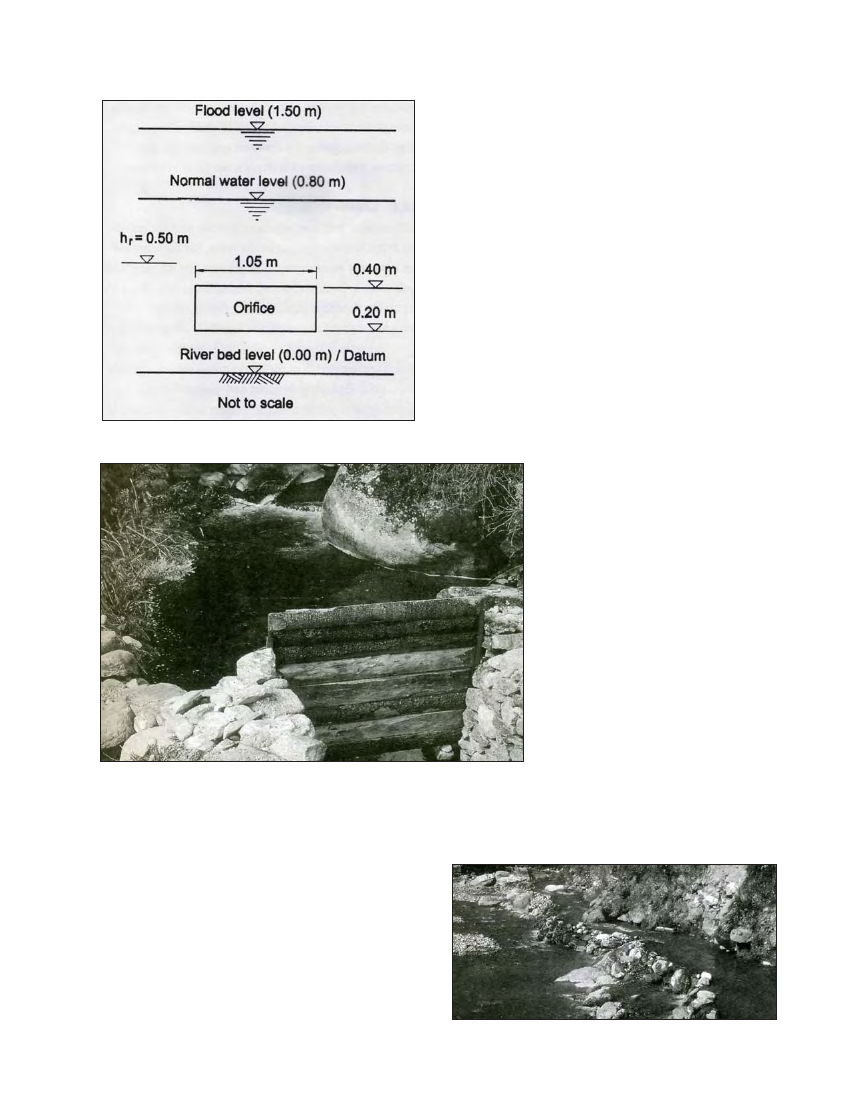
CIVIL WORKS GUIDELINES FOR MICRO-HYDROPOWER IN NEPAL
27
intake). This makes the structure more stable, less
susceptible to flood damage and also minimises sediment
deposition.
3.6.2 TEMPORARY WEIRS
A temporary weir is typically constructed using boulders placed
across part or all of the river width. A diagonal alignment may
reduce the required height of the weir above the riverbed.
This is the traditional method used by Nepali farmers to feed
irrigation canals or water mills (ghattas), and is used quite
extensively in micro-hydro schemes in Nepal. For micro-hydro
schemes in the lower range such as those used for
agroprocessing only, this type of weir is often appropriate.
Figure 3.6 Dimensions of the orifice and levels
Though a temporary weir is simple and low cost, it has a few
limitations: for example it is not possible to divert all of the
river flow, even in the dry season. Therefore this type of weir
is best suited to situations where the dry season flow of the
river exceeds the plant’s design discharge.
During the high flows, even if the weir is washed away, it
may still be possible to divert the required
flow towards the headrace since the water
level in the river is high.
A proposal for a temporary weir constructed
of stone masonry in mud mortar is shown in
Figure 3.7. This is intended to allow diversion
of a higher proportion of the dry season flow,
but would still get washed away during the
annual floods. Constructing temporary weirs
with boulders as large as can be handled
manually and including cut-off walls and
riprap can minimise flood damage. As can be
seen in Figure 3.7, cut-off walls are downward
extensions of the weir at the upstream and
downstream faces that reduce seepage past
the weir. Riprap is an engineering term used
to denote the placing of a layer of boulders for
scour protection. The omission of scour
Photo 3.5 Timber planks placed horizontally in grooves provide a low-cast gate in a
channel. In this case, the timbers have been lifted to act as a restricting orifice (Mhapung)
protection would result in scouring of the
riverbed, eventually leading to the failure of
a weir, attention must be given to the geomorphology of the
the weir itself.
river, and any changes that may be taking place. Always consult
with local people to establish whether the river is eroding (a
general lowering of the river-bed), aggrading (a general
building up of the riverbed), or shifting its course. The
headworks design, and in particular the choice of weir, must
take account of possible future changes. When it becomes
apparent that a weir is required, the following factors should
be considered for both permanent and temporary weirs:
If a weir across part of the river length is sufficient, then it
should not be extended across the entire width. Apart from
adding extra cost it also encourages sediment deposition
upstream of the weir.
The weir height should be as low as possible (i.e., weir crest
level = hr, just sufficient to maintain the water level in the
Photo 3.6 A temporary weir in Type 2B river (Dhading)